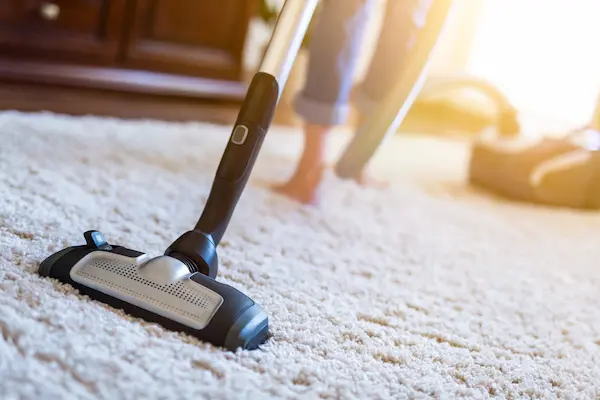Valuable carpets need cleaning regularly to avoid soiling your floors or setting off allergies and asthmatic symptoms. But as a committed homeowner, you probably want to know that your carpets are dry before you walk on them.
Carpets that aren’t dry can be dangerous if you trip over them. So how long does it take carpets to dry after cleaning?
We’ve got an answer. We’ll take a detailed look at the carpet cleaning process. So read on to find out how long it takes your carpets to dry after cleaning.
What Is the Process of Carpet Cleaning?
Carpet cleaning is the process of removing dirt, dust, and carpet allergens from your carpets. Here is an overview of the process:
Identifying Problem Areas
Identifying problem areas when cleaning carpets is a fundamental part of the process. Prior to beginning, it’s important to assess the carpets. You’ll need to identify and target soiled areas and decide the size and shape of the area that needs to be addressed.
Oftentimes, carpets that have not been vacuumed or properly maintained will require a more rigorous cleaning process. Noting problem areas can assist in finding the most effective cleaning solution.
Additionally, care should be taken to always assess carpets prior to treatments for existing issues such as stains, dust or dirt. Drawing attention to sections of a carpet with more noticeable dirt or wear can determine how much product or effort will be necessary.
Straining Out Dirt and Debris
One of the first steps in the process of carpet cleaning is straining out dirt and debris. This process involves vacuuming the carpets using a heavy-duty vacuum cleaner. Commercial carpet cleaning services will thoroughly go over each inch of the carpet to suction up all the dirt and other debris.
Depending on the level of soiling, you might need to repeat this step several times until you get all the dirt out. The key is not to rush and be sure to get out all the dirt and debris. After this step is complete, it is time to move on to the next step in the process, which is usually spot and stain removal.
Deep Cleaning
The deep cleaning process begins with vacuuming to remove dirt and debris from the surface of the carpets. Next, the carpets are treated with a special carpet cleaner that helps lift away deep-seated dirt and stains. After the treatment, the carpets are steamed to sanitize the carpets and protect against the future build-up of dirt and allergens.
Rinsing
Rinsing carpets involves the removal of soap and the loosening of dirt particles. This ensures the carpets will be thoroughly cleaned. It is usually done with hot, clean water passed through the carpets using a machine.
Water-based cleaning solutions or detergents can be added to the full tank of hot water to help dissolve soil and oils. The hot water loosens dirt and oils stuck in the fibers without leaving behind any residue.
After the water has been circulated through the carpet, an additional rinse cycle is recommended. This will ensure all the detergent and dirt are removed from the fibers.
Rinsing with fresh water ensures the carpets are cleaned. And it also helps preserve them and maintain their original condition.
Drying the Carpet
Once the carpet is steam cleaned and vacuumed, it is time to dry the carpet. Drying the carpet correctly can help protect it from further damage and staining.
To dry the carpet, it is best to increase air circulation by opening windows or turning on fans. Prolonged direct sunlight should be avoided, as this could damage the fibers.
Professional cleaners may also use drying machines to help with this process. These machines can draw the moisture out of the woven fibers of the carpet, which helps decrease the carpet drying time.
For additional steps, you can also place a carpet over the wet carpet to soak up the moisture. If a do-it-yourself approach is taken, large towels can also be used. Once this step is complete, it is important to inspect the carpet for any areas that have not been dried completely.
If the carpet appears to be dry, a vacuum is used to remove any loose soil particles and clean the carpet. Finally, furniture, rugs, and other objects should be placed back on the carpet.
So How Long Does It Take Carpets to Dry After Cleaning?
Cleaning carpets can be an arduous task, and figuring out how long it will take for carpets to dry after the process can be just as difficult. Typically, carpets can take anywhere from 30 minutes to 72 hours to dry after a deep steam clean. If carpets have heavily soiled areas that require pretreatment, there can be some additional drying time needed.
To ensure the carpets are dry, you should do a test spot before walking on the carpet and leaving the furniture back in place. If some areas are still damp, extra time is needed.
Factors that can affect the drying time include the state of the carpet, how much traffic is walking on the carpets again, and temperature and humidity levels in the home.
What Are Effective Preservation Techniques for Carpets?
You should do vacuuming at least once per week to remove dirt, dust, and other particles. You should also use spot treatment immediately on any spills or stains to prevent staining.
You should also rotate your carpets to avoid excessive wear in high-traffic areas. And you can also use an appropriate rug pad to help further extend its lifetime, as the pad absorbs shock and foot traffic.
Professional carpet cleaning should be performed every few months to deep clean carpets. This protects it against the accumulation of allergens and bacteria.
Cleaning Your Carpet Is Important
Carpet cleaning can remove dust, dirt, and allergens from our homes, but it’s important to factor in the drying time. The answer to “How long does it take carpets to dry after cleaning?” will vary depending on the type of cleaning method used.
So make sure to plan enough time for your carpet to dry thoroughly after cleaning. Soon enough, you’ll be walking on a cleaned carpet and living in comfort.
Did you find this article helpful? If so, check out the rest of our site for more.







